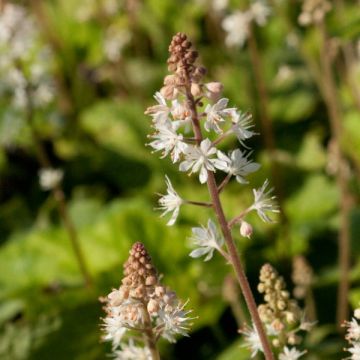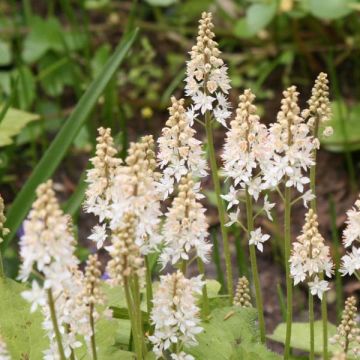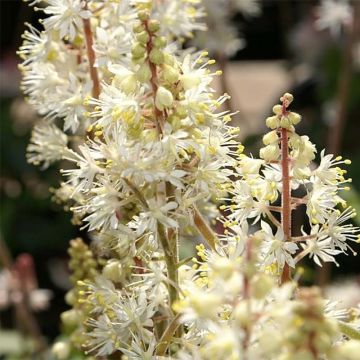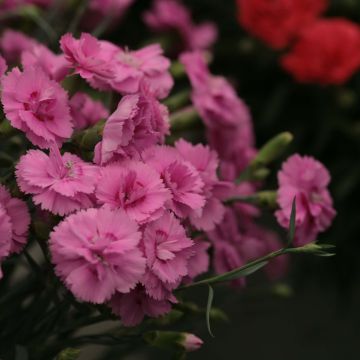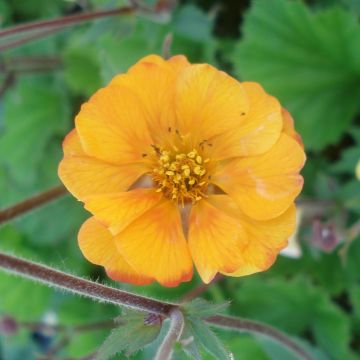

Heucherella Onyx
Heucherella Onyx
(x) Heucherella Onyx
Foamy Bells
She arrived fresh and in good shape, no problem acclimatizing and already very beautiful.
Magaly, 19/05/2020
This item cannot be shipped to the selected country
Delivery charge from €5.90
More information
Schedule delivery date,
and select date in basket
This plant carries a 12 months recovery warranty
More information
We guarantee the quality of our plants for a full growing cycle, and will replace at our expense any plant that fails to recover under normal climatic and planting conditions.
From €5.90 for pickup delivery and €6.90 for home delivery
Express home delivery from €8.90.
Does this plant fit my garden?
Set up your Plantfit profile →
Description
With its splendid glossy foliage of almost black-purple, x Heucherella 'Onyx' is undoubtedly the darkest of the hybrids between heuchera and tiarella currently available. This beautiful new plant, of medium size, forms a dense clump of leaves, from which numerous graceful flowering stems emerge in early summer, reminiscent of those of heucheras, adorned with small white bells. Hardy and tolerant, it is an excellent perennial for partially shaded and cool areas of the garden, in light woodland. It will also make a great statement in a pot on a patio or balcony!
Heucherella 'Onyx' belongs, like its ancestors heuchera and tiarella, to the Saxifragaceae family. It has inherited the best qualities of these two plants: the spectacular foliage of heuchera and the abundant flowering and superior robustness of tiarella. It is an evergreen to semi-evergreen perennial, growing in a low and compact clump. At maturity, it reaches 25cm (10in) in height (for the foliage), 40cm (16in) in flower, and 40cm (16in) in width. The leaves measure 5 to 10cm (2 to 4in) in diameter. The leaves that emerge in spring are narrower. They give way to larger, rather round leaves, strongly lobed at the edges, with prominent veins. They are dark purple on the upper side, and purple on the underside. The lamina has a beautiful satin appearance that enhances the depth of the colour. The very long-lasting flowers appear in June-July, grouped in condensed spikes, carried by thin and hairy stems that are 40cm (16in) tall. This white flowering with tiny bells gives an impression of foam.
Heucherella 'Onyx' appreciates wooded environments with a humid atmosphere. It is less sensitive than heuchera to the combination of heat and humidity. It naturally finds its place in moist woodland alongside ferns, Impatiens balfouri, Solomon's seal, and astilbe. It is also a good border plant to surround hydrangeas and camellias, for perennial beds, or in a rockery. Keep it away from the blazing sun. It can also be used as a waterside plant. It will thrive in containers or sheltered gardens away from direct sunlight. It should be planted in well-drained compost without excessive fertilisers. Water in summer. Reduce watering in winter. Pots will need protection against cold winter winds.
Report an error about the product description
Heucherella Onyx in pictures


Flowering
Foliage
Plant habit
Botanical data
(x) Heucherella
Onyx
Saxifragaceae
Foamy Bells
Cultivar or hybrid
Other Tiarellas and Heucherellas
Planting and care
Easy to maintain, 'Onyx' thrives in all types of moist to wet, well-drained soils, preferably neutral to acidic. It can be planted in partial shade or dense shade (although the foliage colour may be duller in this case). Morning sun is well tolerated, especially in moist soil. Full sun should be avoided at all costs. It should be planted in loose soil that retains moisture, with the option of adding mulch. It does not tolerate very hot conditions and appreciates high humidity. Once established, this perennial seems to tolerate dry shade under trees and bushes in the summer. It requires little maintenance and pruning is not necessary unless the foliage is damaged or you want to rejuvenate the plant.
Planting period
Intended location
Care
-
, onOrder confirmed
Reply from on Promesse de fleurs
Summer flowering perennials
Haven't found what you were looking for?
Hardiness is the lowest winter temperature a plant can endure without suffering serious damage or even dying. However, hardiness is affected by location (a sheltered area, such as a patio), protection (winter cover) and soil type (hardiness is improved by well-drained soil).

Photo Sharing Terms & Conditions
In order to encourage gardeners to interact and share their experiences, Promesse de fleurs offers various media enabling content to be uploaded onto its Site - in particular via the ‘Photo sharing’ module.
The User agrees to refrain from:
- Posting any content that is illegal, prejudicial, insulting, racist, inciteful to hatred, revisionist, contrary to public decency, that infringes on privacy or on the privacy rights of third parties, in particular the publicity rights of persons and goods, intellectual property rights, or the right to privacy.
- Submitting content on behalf of a third party;
- Impersonate the identity of a third party and/or publish any personal information about a third party;
In general, the User undertakes to refrain from any unethical behaviour.
All Content (in particular text, comments, files, images, photos, videos, creative works, etc.), which may be subject to property or intellectual property rights, image or other private rights, shall remain the property of the User, subject to the limited rights granted by the terms of the licence granted by Promesse de fleurs as stated below. Users are at liberty to publish or not to publish such Content on the Site, notably via the ‘Photo Sharing’ facility, and accept that this Content shall be made public and freely accessible, notably on the Internet.
Users further acknowledge, undertake to have ,and guarantee that they hold all necessary rights and permissions to publish such material on the Site, in particular with regard to the legislation in force pertaining to any privacy, property, intellectual property, image, or contractual rights, or rights of any other nature. By publishing such Content on the Site, Users acknowledge accepting full liability as publishers of the Content within the meaning of the law, and grant Promesse de fleurs, free of charge, an inclusive, worldwide licence for the said Content for the entire duration of its publication, including all reproduction, representation, up/downloading, displaying, performing, transmission, and storage rights.
Users also grant permission for their name to be linked to the Content and accept that this link may not always be made available.
By engaging in posting material, Users consent to their Content becoming automatically accessible on the Internet, in particular on other sites and/or blogs and/or web pages of the Promesse de fleurs site, including in particular social pages and the Promesse de fleurs catalogue.
Users may secure the removal of entrusted content free of charge by issuing a simple request via our contact form.
The flowering period indicated on our website applies to countries and regions located in USDA zone 8 (France, the United Kingdom, Ireland, the Netherlands, etc.)
It will vary according to where you live:
- In zones 9 to 10 (Italy, Spain, Greece, etc.), flowering will occur about 2 to 4 weeks earlier.
- In zones 6 to 7 (Germany, Poland, Slovenia, and lower mountainous regions), flowering will be delayed by 2 to 3 weeks.
- In zone 5 (Central Europe, Scandinavia), blooming will be delayed by 3 to 5 weeks.
In temperate climates, pruning of spring-flowering shrubs (forsythia, spireas, etc.) should be done just after flowering.
Pruning of summer-flowering shrubs (Indian Lilac, Perovskia, etc.) can be done in winter or spring.
In cold regions as well as with frost-sensitive plants, avoid pruning too early when severe frosts may still occur.
The planting period indicated on our website applies to countries and regions located in USDA zone 8 (France, United Kingdom, Ireland, Netherlands).
It will vary according to where you live:
- In Mediterranean zones (Marseille, Madrid, Milan, etc.), autumn and winter are the best planting periods.
- In continental zones (Strasbourg, Munich, Vienna, etc.), delay planting by 2 to 3 weeks in spring and bring it forward by 2 to 4 weeks in autumn.
- In mountainous regions (the Alps, Pyrenees, Carpathians, etc.), it is best to plant in late spring (May-June) or late summer (August-September).
The harvesting period indicated on our website applies to countries and regions in USDA zone 8 (France, England, Ireland, the Netherlands).
In colder areas (Scandinavia, Poland, Austria...) fruit and vegetable harvests are likely to be delayed by 3-4 weeks.
In warmer areas (Italy, Spain, Greece, etc.), harvesting will probably take place earlier, depending on weather conditions.
The sowing periods indicated on our website apply to countries and regions within USDA Zone 8 (France, UK, Ireland, Netherlands).
In colder areas (Scandinavia, Poland, Austria...), delay any outdoor sowing by 3-4 weeks, or sow under glass.
In warmer climes (Italy, Spain, Greece, etc.), bring outdoor sowing forward by a few weeks.


































